 In our ongoing series of articles about car audio electrical theory, we are going to introduce the concept of alternating current power sources and signals. Understanding the basics of AC is crucial to understanding how a mobile audio system works. This article uses a lot of references to the electricity delivery systems used in our homes and offices to help establish a basic understanding of AC circuits. We’ll build on this foundation in this and subsequent articles to help form an understanding of the complexities of AC systems.
In our ongoing series of articles about car audio electrical theory, we are going to introduce the concept of alternating current power sources and signals. Understanding the basics of AC is crucial to understanding how a mobile audio system works. This article uses a lot of references to the electricity delivery systems used in our homes and offices to help establish a basic understanding of AC circuits. We’ll build on this foundation in this and subsequent articles to help form an understanding of the complexities of AC systems.
The Difference Between AC and DC
 The voltage produced by the electrical system in our vehicles is called direct current. The electrons flow in one direction from one terminal of the battery to the other (except when we are recharging the battery). While there are changes in the voltage level as we add loads to the circuit, or when the alternator starts recharging the battery, the direction of current flow to the electric and electronic devices in the vehicle never changes.
The voltage produced by the electrical system in our vehicles is called direct current. The electrons flow in one direction from one terminal of the battery to the other (except when we are recharging the battery). While there are changes in the voltage level as we add loads to the circuit, or when the alternator starts recharging the battery, the direction of current flow to the electric and electronic devices in the vehicle never changes.
Conversely, the power supplied by your local electric company to drive the lights and appliances our homes and at work is called alternating current. It has this name because the flow of electrons changes direction 60 times a second. Yes, this sounds weird. Who would want their power to go back and forth? Don’t fret; we’ll explain it all shortly. Just keep reading.
Power Loss in Transmission Wires
 Researchers believe that the first electrical power source was a clay pot that contained tin plates and an iron rod. If filled with an acidic solution like vinegar, a voltage would be produced on the metal terminals. The belief is that this first battery was created more than 2,000 years ago. All batteries are direct current power sources.
Researchers believe that the first electrical power source was a clay pot that contained tin plates and an iron rod. If filled with an acidic solution like vinegar, a voltage would be produced on the metal terminals. The belief is that this first battery was created more than 2,000 years ago. All batteries are direct current power sources.
Using electricity to do work started to become popular in the late 1800s, and as such, the need to deliver electricity to homes and offices became necessary. The problem with delivering power over long distances is voltage loss in the wires because of their resistance.
As we know from Ohm’s law and the power calculations we have recently discussed, the power in a circuit is directly proportional to the current and voltage (P = I x V) in the circuit. Power is also proportional to the square of current in the circuit relative to the resistance (P = I^2 x R). If we can transmit power with more voltage and less current, less power is wasted in the transmission wires.
Adoption of Alternating Current
A significant benefit of alternating current power supplies in commercial and residential applications is that it is easy to change the relationship between voltage and current using a transformer. A transformer is a device that uses magnetic fields to increase or decrease the voltage to current ratio. For example, an ideal 2:1 transformer would convert 10 volts and five amps of AC to five volts and 10 amps.
George Westinghouse is credited with the popularization of the delivery of AC power to homes, thanks to being awarded the contract to supply power to light the 1893 World’s Fair Columbian Exposition. Westinghouse used transformers based on patents he purchased from Lucien Gaulard and John Dixon Gibbs. Gaulard and Gibbs invented the transformer in London in 1881.
 The output of a generator in a nuclear, coal or hydroelectric plant is 20 to 22 kilovolts. This voltage is stepped up to between 155,000 to 765,000 volts using a transformer for distribution around the state or province. Most of the high-voltage towers you see along the highway or in clearings have around 500,000 volts flowing through the three power conductors.
The output of a generator in a nuclear, coal or hydroelectric plant is 20 to 22 kilovolts. This voltage is stepped up to between 155,000 to 765,000 volts using a transformer for distribution around the state or province. Most of the high-voltage towers you see along the highway or in clearings have around 500,000 volts flowing through the three power conductors.
Each city or portion of a city will have some type of electrical substation where the electricity from these high-voltage lines is stepped down to lower voltages for distribution around different neighborhoods. These voltages are usually in the 16kV range to maintain an adequate level of transmission efficiency over these short to moderate distances. Transformers in enclosures at the side of the road or installed underground convert that voltage to the 120V feeds that run to the electrical panels in our homes.
By way of an example, let’s look at 1 mile of 8 AWG stranded cable. According to the American Wire Gauge standard, 1 mile of 8 AWG copper wire will have a maximum resistance of 3.782 ohms and an ideal resistance of 3.6 ohms.
 If we want 5,000 watts of power delivered through this mile of cable, there will be some energy lost to the resistance in the cable. If we transmit our power at 240 volts, there will be 20.83 amps of current flowing in the cable. With a resistance of 3.6 ohms, the cable itself causes a loss of 1562.5 and we lose 75 volts across the cable. Clearly, low-voltage signal transmission over long distances doesn’t work.
If we want 5,000 watts of power delivered through this mile of cable, there will be some energy lost to the resistance in the cable. If we transmit our power at 240 volts, there will be 20.83 amps of current flowing in the cable. With a resistance of 3.6 ohms, the cable itself causes a loss of 1562.5 and we lose 75 volts across the cable. Clearly, low-voltage signal transmission over long distances doesn’t work.
If we increase the voltage up to 16,000 volts, the power loss in the cable drops to 0.3125 watts and we only lose 1.125 volts to the cable.
High-voltage transmission lines are how electric companies can deliver megawatts of electricity over long distances with minimal power loss. At 500,000 volts, we can transmit 1 megawatt of electricity over 100 miles and lose only 720 volts. That’s 0.144 percent!
OK, enough about the relationship of AC power and voltage. Let’s talk about audio systems.
A First Look at Audio Signals
Unlike the 60Hz AC waveform that feeds our homes, audio signals contain voltage information that mimics the changes in air pressure that we would perceive as sound. In most cases, sounds are recorded using a microphone that works in the opposite way a speaker does. Sound energy moves a small diaphragm that includes a coil of wire. The coil of wire moves past a fixed magnet. The motion of the coil through the magnetic field induces a voltage in the wire. The distance the diaphragm moves determines the amplitude of the voltage signal. Louder sounds produce higher voltages.
Below is a picture of an audio waveform as seen on an oscilloscope. The person speaking said the word audio.
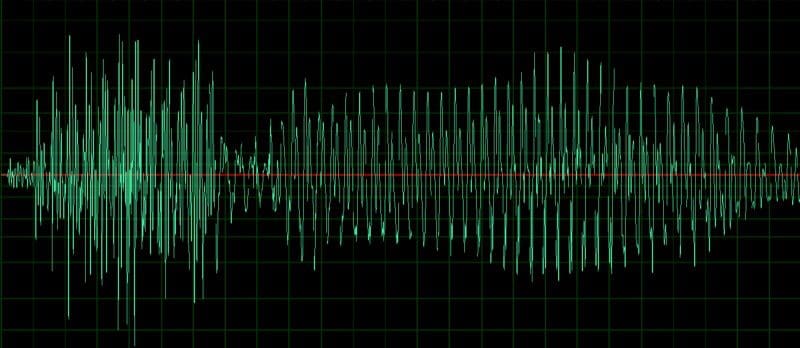
Understanding Power in Alternating Current Circuits
The basic concept of power in an AC circuit is the same as for a DC circuit, but some calculations need to be completed before we can apply Ohm’s law. We’ll look at the 120V, 60Hz residential power supply to explain the math in the simplest of terms.
To measure power, we need to look at the amount of work completed over a given period. In the case of a light bulb plugged into an outlet, the filament doesn’t care which direction current is flowing, but the amount of light and heat created depends on the amplitude of the voltage supplied. The work done by the bulb is calculated by the number of electrons that flow through the bulb for a given amount of time.
To determine the work done by an AC voltage, we need to calculate the value of that signal that does the same amount of work as a DC voltage. This value is called the RMS or root mean square value and is 1/sqrt 2, or 0.70711 for sine waves. For our 120V power feed coming out of the wall, 120V volts is the RMS voltage. The peak voltage is about 167.7 volts. To be clear, the value of 0.70711 only works for a sinusoidal waveform. The RMS value of a square wave is 1.0 and for a symmetrical triangle wave is 0.577.
By definition, the RMS AC voltage can perform the same amount of work as DC voltage of the same value.
The image below shows a single cycle of a sinusoidal waveform. The peak voltage is 167.7 volts, and the two orange lines define the RMS value of 120V.
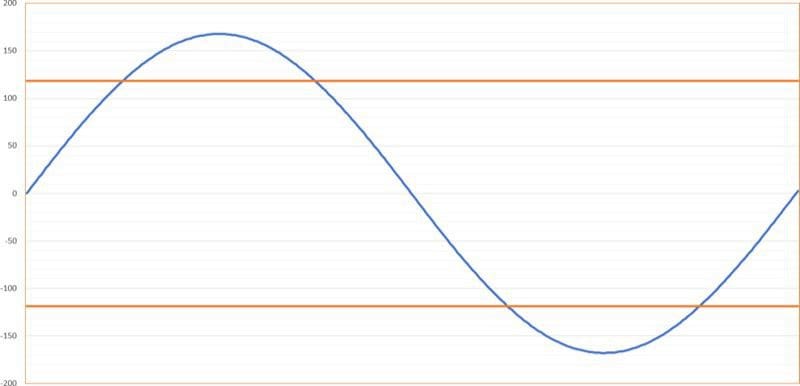
Basic Understanding of Alternating Current Sources and Signals
For this article, the takeaway is that the audio waveforms on the preamp and speaker wires in our stereo system are alternating current signals. In the next article, we will discuss the concept of frequency and amplitude in more detail.
This article is written and produced by the team at www.BestCarAudio.com. Reproduction or use of any kind is prohibited without the express written permission of 1sixty8 media.
 For several years, the Best Car Audio team has provided articles on the features, functions and benefits of all manner of
For several years, the Best Car Audio team has provided articles on the features, functions and benefits of all manner of  In its most basic of terms, electricity is a group of charged electrons that can be used to do work. The electricity in our cars comes from two sources: the battery and the alternator. After the battery is used to start the car, the alternator recharges the
In its most basic of terms, electricity is a group of charged electrons that can be used to do work. The electricity in our cars comes from two sources: the battery and the alternator. After the battery is used to start the car, the alternator recharges the  It’s important to know the quantity of electricity moving through a circuit. We use the SI unit ampere to quantify the volume of electrons moving in a conductor. The original definition for the ampere involved quantification of the magnetic force created between two infinitely long parallel conductors (wires). While this is a valid definition, it’s never used in schools or any training. A simpler explanation is that 1 amp of current is equivalent to 6.2415093 × 10^18 elementary charges moving through a boundary over a period of one second. An elementary charge is the is the electric charge carried by a single proton.
It’s important to know the quantity of electricity moving through a circuit. We use the SI unit ampere to quantify the volume of electrons moving in a conductor. The original definition for the ampere involved quantification of the magnetic force created between two infinitely long parallel conductors (wires). While this is a valid definition, it’s never used in schools or any training. A simpler explanation is that 1 amp of current is equivalent to 6.2415093 × 10^18 elementary charges moving through a boundary over a period of one second. An elementary charge is the is the electric charge carried by a single proton. Resistance is the description of the opposition to the flow of current in a circuit. We use the SI unit ohm to quantify this value. Unlike voltage and current, the symbol used to represent resistance is the uppercase Greek letter omega: Ω. More resistance in a circuit reduces the ability for electrons to flow and thereby decreases the number of amps flowing.
Resistance is the description of the opposition to the flow of current in a circuit. We use the SI unit ohm to quantify this value. Unlike voltage and current, the symbol used to represent resistance is the uppercase Greek letter omega: Ω. More resistance in a circuit reduces the ability for electrons to flow and thereby decreases the number of amps flowing. Thankfully, in simple circuits, the relationship between voltage, current and resistance is linear. When we have more voltage available, more current flows for a given resistance. Likewise, less resistance in a circuit causes more current to flow for a given voltage. Ohm’s law is a simple mathematical equation that allows you to calculate any of the three values, provided you know two others.
Thankfully, in simple circuits, the relationship between voltage, current and resistance is linear. When we have more voltage available, more current flows for a given resistance. Likewise, less resistance in a circuit causes more current to flow for a given voltage. Ohm’s law is a simple mathematical equation that allows you to calculate any of the three values, provided you know two others. In any discussion about understanding
In any discussion about understanding  Sound is a vibration of air molecules that vibrates our eardrums. The eardrum passes these vibrations through to the middle ear through tiny bones called ossicles. The inner ear has a shape similar to that of a snail shell and contains microscopic hair cells that convert these vibrations into minute electrical signals. These signals are transmitted to the hearing nerve and subsequently to our brain. Each inner ear contains roughly 18,000 hair cells, all of which are said to fit on the head of a pin. Once a hair cell is damaged, it never grows back or repairs itself.
Sound is a vibration of air molecules that vibrates our eardrums. The eardrum passes these vibrations through to the middle ear through tiny bones called ossicles. The inner ear has a shape similar to that of a snail shell and contains microscopic hair cells that convert these vibrations into minute electrical signals. These signals are transmitted to the hearing nerve and subsequently to our brain. Each inner ear contains roughly 18,000 hair cells, all of which are said to fit on the head of a pin. Once a hair cell is damaged, it never grows back or repairs itself. When discussing sound levels, the proper format is to use the unit dB SPL, dB(SPL) or dBSPL. The reference for any statement is the sound pressure as compared to 0dB. 0dB is defined as the perceived sound of a mosquito at a distance of 10 feet from the listener.
When discussing sound levels, the proper format is to use the unit dB SPL, dB(SPL) or dBSPL. The reference for any statement is the sound pressure as compared to 0dB. 0dB is defined as the perceived sound of a mosquito at a distance of 10 feet from the listener. According to Guinness World Records, the quietest place in the world in 2012 was an anechoic test chamber at Orfield Laboratories in Minneapolis. The sound level in this room was measured at -13dBA. In October 2015, a team of engineers at the Microsoft head office in Redmond, Washington, smashed this record with measurements taken in the anechoic chamber in Building 87. A team of independent specialists measured a noise level of -20.35 dBA. The room is not only completely isolated from all sources of noise and vibration, but the walls are lined with large acoustic foam wedges design to absorb sound.
According to Guinness World Records, the quietest place in the world in 2012 was an anechoic test chamber at Orfield Laboratories in Minneapolis. The sound level in this room was measured at -13dBA. In October 2015, a team of engineers at the Microsoft head office in Redmond, Washington, smashed this record with measurements taken in the anechoic chamber in Building 87. A team of independent specialists measured a noise level of -20.35 dBA. The room is not only completely isolated from all sources of noise and vibration, but the walls are lined with large acoustic foam wedges design to absorb sound.
 Many statements about sound levels get thrown around the industry. Let’s talk about and clarify a couple of the most common.
Many statements about sound levels get thrown around the industry. Let’s talk about and clarify a couple of the most common. Just for fun and education, below is a series of test tones to demonstrate our ability to detect differences in amplitude. These tests are created to make the differences as easily perceivable as possible.
Just for fun and education, below is a series of test tones to demonstrate our ability to detect differences in amplitude. These tests are created to make the differences as easily perceivable as possible. There is nothing worse than turning up your
There is nothing worse than turning up your 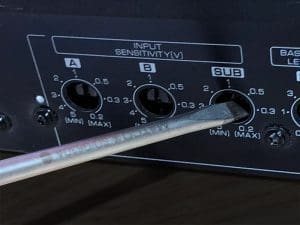 When a mobile electronics specialist installs an amplifier in your vehicle, the
When a mobile electronics specialist installs an amplifier in your vehicle, the  Perhaps the most dangerous control on an
Perhaps the most dangerous control on an 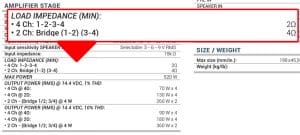 If you have multiple
If you have multiple  If your radio has an equalizer or simple bass and treble controls, turning them up will make different frequencies of your music louder relative to others. With that said, it won’t make a properly configured and tuned audio system play any louder. Just like the bass boost on an amp, equalizers and tone controls affect the signal level at specific frequencies.
If your radio has an equalizer or simple bass and treble controls, turning them up will make different frequencies of your music louder relative to others. With that said, it won’t make a properly configured and tuned audio system play any louder. Just like the bass boost on an amp, equalizers and tone controls affect the signal level at specific frequencies. All speakers and subwoofers have power ratings. In almost all cases, this rating is the amount of power that the speaker can manage from a thermal standpoint. You see, speakers are notoriously inefficient. More than 95 percent of the energy fed into a speaker is converted to heat. If you feed a woofer 100 watts of power, 95 watts go into heating the voice coil and motor assembly and less than 5 watts are converted into acoustic energy.
All speakers and subwoofers have power ratings. In almost all cases, this rating is the amount of power that the speaker can manage from a thermal standpoint. You see, speakers are notoriously inefficient. More than 95 percent of the energy fed into a speaker is converted to heat. If you feed a woofer 100 watts of power, 95 watts go into heating the voice coil and motor assembly and less than 5 watts are converted into acoustic energy. Another consideration about amplifiers is that most can produce 150 percent to 200 percent of their rated power as extra energy when pushed into clipping or distortion. So, a 50-watt amplifier can easily produce 75 watts of distorted power and still damage that 70-watt speaker.
Another consideration about amplifiers is that most can produce 150 percent to 200 percent of their rated power as extra energy when pushed into clipping or distortion. So, a 50-watt amplifier can easily produce 75 watts of distorted power and still damage that 70-watt speaker. Shopping for car audio upgrades is as personal as shopping for a new car or new shoes. Each of us likes something different, has a different budget and different performance and style preferences. In the case of a new car, your options range from a solid and reliable daily driver in the $14,000 range to luxury and exotic vehicles costing well over $100,000. When it comes to a new radio, speakers, an amplifier or a subwoofer upgrade for your car, the price point differs just as much, as do the features and performance levels. In this article, we will provide some tips to prepare yourself to buy new car audio upgrades and ensure they are installed and configured reliably.
Shopping for car audio upgrades is as personal as shopping for a new car or new shoes. Each of us likes something different, has a different budget and different performance and style preferences. In the case of a new car, your options range from a solid and reliable daily driver in the $14,000 range to luxury and exotic vehicles costing well over $100,000. When it comes to a new radio, speakers, an amplifier or a subwoofer upgrade for your car, the price point differs just as much, as do the features and performance levels. In this article, we will provide some tips to prepare yourself to buy new car audio upgrades and ensure they are installed and configured reliably. A discussion about online shopping opens a monumental can of worms. One of the biggest differences between buying from an online retailer and a local independent specialist will be the level of after-sales service and support. If you buy new speakers online and you have a problem with them, you can try contacting the supplier. About all they can do is offer to let you send the speakers back (at your cost) and they will send you another set. When you deal with a local retailer, someone can go to your car and listen to the problem. The issue may not be the speakers at all. It could be the
A discussion about online shopping opens a monumental can of worms. One of the biggest differences between buying from an online retailer and a local independent specialist will be the level of after-sales service and support. If you buy new speakers online and you have a problem with them, you can try contacting the supplier. About all they can do is offer to let you send the speakers back (at your cost) and they will send you another set. When you deal with a local retailer, someone can go to your car and listen to the problem. The issue may not be the speakers at all. It could be the  Make no doubt, most of the installers, technicians and fabricators who work at mobile electronics retailers got their start working on their vehicles in their driveway. In some cases, this passion for working on cars and trucks grew to include their friends’ vehicles, while others sought out training from companies like
Make no doubt, most of the installers, technicians and fabricators who work at mobile electronics retailers got their start working on their vehicles in their driveway. In some cases, this passion for working on cars and trucks grew to include their friends’ vehicles, while others sought out training from companies like 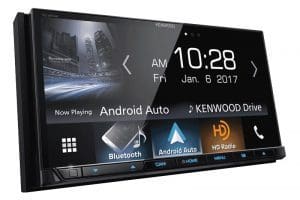 When it comes to source unit upgrades, the first thing you need to find out is whether or not you can replace the factory radio in the vehicle at all. Vehicles such as BMW, Mercedes-Benz, Mazda and many new Nissan vehicles have source units that can’t be removed.
When it comes to source unit upgrades, the first thing you need to find out is whether or not you can replace the factory radio in the vehicle at all. Vehicles such as BMW, Mercedes-Benz, Mazda and many new Nissan vehicles have source units that can’t be removed. Perhaps the most important component in an audio system is the speakers.
Perhaps the most important component in an audio system is the speakers. 
 When you go shopping, bring one or two pieces of music that you know well. Before you leave your house, listen to that song on as many different sources as possible: your home theatre system, a portable Bluetooth speaker, headphones with your smartphone and your existing stereo. Think about what is different between each experience so you can listen for those elements as you audition new products.
When you go shopping, bring one or two pieces of music that you know well. Before you leave your house, listen to that song on as many different sources as possible: your home theatre system, a portable Bluetooth speaker, headphones with your smartphone and your existing stereo. Think about what is different between each experience so you can listen for those elements as you audition new products.